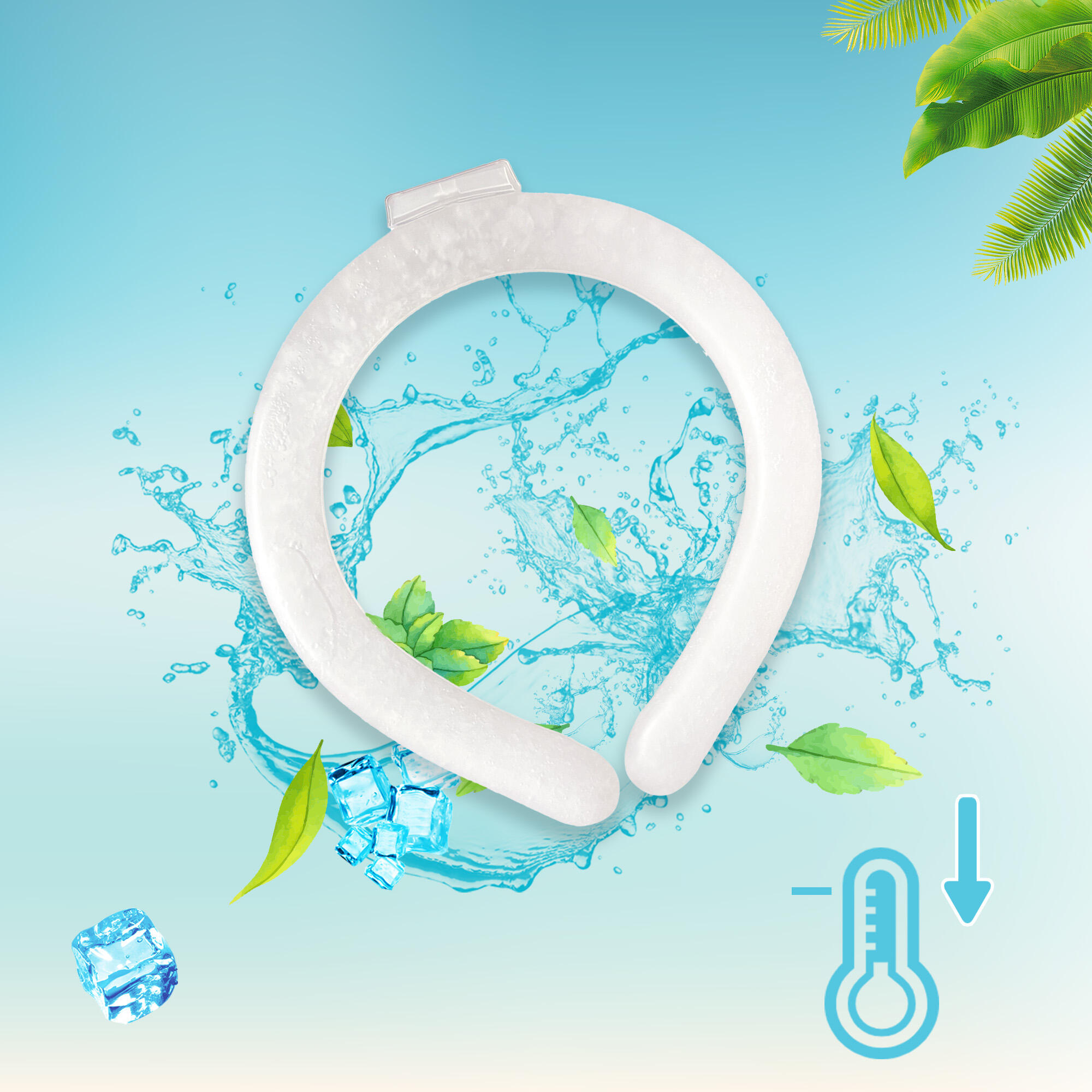ประโยชน์ของการใช้การบำบัดด้วยความเย็นคืออะไร
การบำบัดด้วยความเย็นนั้นถูกใช้มาเป็นเวลานานหลายศตวรรษแล้วในฐานะที่เป็นวิธีการที่เป็นธรรมชาติและมีประสิทธิภาพในการช่วยลดอาการปวด ลดการอักเสบ และส่งเสริมการฟื้นตัวของร่างกาย หนึ่งในรูปแบบที่ใช้ได้ง่ายและหลากหลายที่สุดของบำบัดชนิดนี้คือการใช้ผ้าประคองเย็น ไม่ว่าจะทำจากถุงน้ำแข็ง แผ่นเจลเย็น หรือแม้แต่ผ้าขนหนูที่ชุบน้ำเย็นจนเปียก แผ่นประคบเย็น ให้ความรู้สึกเย็นสบายทันทีที่สามารถนำไปใช้รักษาอาการต่าง ๆ ได้หลากหลาย ความเรียบง่ายและประสิทธิภาพของมันทำให้การประคองเย็นกลายเป็นทางเลือกแรกที่นิยมใช้ภายในบ้าน สถานที่ออกกำลังกาย และในทางการแพทย์
แผ่นประคบเย็น การประคบเย็นทำงานโดยการลดอุณหภูมิของบริเวณเป้าหมาย ผลของการเย็นนี้จะทำให้หลอดเลือดหดตัว ส่งผลให้การไหลเวียนของเลือดลดลงชั่วคราว ด้วยเหตุนี้จึงช่วยลดอาการบวมและอักเสบ รวมทั้งชะลอการทำงานของระบบประสาท ซึ่งช่วยให้อาการปวดชาขึ้นและให้ความรู้สึกสบายมากขึ้น นอกเหนือจากการใช้รักษาอาการบาดเจ็บที่ทราบกันดีอยู่แล้ว ยังมีประโยชน์อีกมากมายของวิธีการประคบเย็นต่อสุขภาพทั่วไปและการดูแลตัวเองในชีวิตประจำวัน บทความนี้จะกล่าวถึงประโยชน์เหล่านี้อย่างละเอียด ครอบคลุมถึงวิธีการและเหตุผลที่การประคบเย็นถูกนำมาใช้ รวมถึงหลักวิทยาศาสตร์ที่เกี่ยวข้อง และแนวทางปฏิบัติที่เหมาะสมที่สุดในการใช้งานอย่างปลอดภัยและมีประสิทธิภาพ
ทำความเข้าใจเกี่ยวกับการประคบเย็น
การประคบเย็น คือการนำอุณหภูมิที่เย็นมาประคบบนร่างกายเพื่อประโยชน์ในการรักษา โดยสามารถทำได้ง่ายๆ เช่น ใช้ผ้าเปียกที่แช่เย็น ถุงน้ำแข็งห่อในผ้าขนหนู หรือแผ่นเจลที่ซื้อตามท้องตลาด ในทางตรงกันข้ามกับการใช้น้ำแข็งวางโดยตรงบนผิวหนัง การประคบเย็นได้รับการออกแบบมาเพื่อให้ความเย็นที่ช่วยบรรเทาอาการ โดยลดความเสี่ยงต่อการเกิดการบาดเจ็บของผิวหนัง
การบำบัดด้วยการประคบเย็นมีพื้นฐานมาจากระบบการตอบสนองทางสรีรวิทยาของร่างกายต่อความเย็น เมื่อร่างกายถูกกระตุ้นด้วยความเย็น เส้นเลือดจะหดตัวในกระบวนการที่เรียกว่าการหดตัวของหลอดเลือด (vasoconstriction) ซึ่งจะช่วยลดการไหลเวียนของเลือดไปยังบริเวณนั้น ชะลอการบวมและอาการอักเสบ นอกจากนี้ ความเย็นยังช่วยลดการรับความรู้สึกของปลายประสาท ทำให้อาการปวดลดลง
ด้วยผลประโยชน์เหล่านี้ ทำให้การใช้ผ้าประคบเย็นได้รับการแนะนำอย่างแพร่หลายจากผู้ให้บริการด้านสุขภาพสำหรับการรักษาอาการต่าง ๆ ตั้งแต่การบาดเจ็บเล็กน้อย อาการปวดหัว ไปจนถึงการใช้เพื่อจุดประสงค์ด้านความงาม
ประโยชน์ของการบำบัดด้วยการประคบเย็น
บรรเทาอาการปวด
การ ป้องกัน ความ ปวด การ ปิด ปวด ซึ่งทําให้มันมีประสิทธิภาพอย่างยิ่งสําหรับบาดเจ็บที่รุนแรง เช่น การบิดขา หรือบาดเจ็บ มันยังมีประโยชน์สําหรับโรคปวดเรื้อรัง ที่การอักเสบส่งผลให้เกิดความไม่สบายใจ
ลดอาการบวมและอักเสบ
การอักเสบเป็นปฏิกิริยาตามธรรมชาติของร่างกายต่อการบาดเจ็บ แต่อาการบวมมากเกินไปอาจทำให้เกิดความเจ็บปวดและชะลอการฟื้นตัว การบำบัดด้วยการประคบร้อนลดการตอบสนองนี้โดยการจำกัดการไหลเวียนของเลือดไปยังบริเวณที่บาดเจ็บ นี่จึงเป็นเหตุผลที่นักกีฬามักใช้การประคบร้อนทันทีหลังได้รับบาดเจ็บ เพื่อควบคุมอาการบวมและส่งเสริมการฟื้นตัวให้รวดเร็วขึ้น
การบรรเทาอาการปวดหัวและไมเกรน
การประคบร้อนบริเวณหน้าผาก ขมับ หรือด้านหลังของคอ เป็นวิธีที่รู้จักกันดีสำหรับการบรรเทาอาการปวดหัวและไมเกรน ผลของการเย็นจะช่วยลดการขยายตัวของหลอดเลือดซึ่งมักเกี่ยวข้องกับอาการปวดไมเกรน หลายคนรายงานว่าการประคบร้อนช่วยบรรเทาอาการปวดหัวได้อย่างรวดเร็วและมีประสิทธิภาพ ทำให้เป็นทางเลือกที่นิยมใช้ในการบรรเทาอาการโดยไม่ต้องใช้ยา
ความสบายในการลดไข้
การประคบเย็นมักถูกใช้เพื่อช่วยลดอุณหภูมิของร่างกายในช่วงที่มีไข้ การวางผ้าประคบเย็นที่หน้าผาก คอ หรือข้อมือสามารถช่วยให้รู้สึกสบายขึ้นและลดอาการร้อนเกินที่เกิดขึ้น แม้ว่าวิธีนี้จะไม่สามารถรักษาสาเหตุที่ทำให้เกิดไข้ได้โดยตรง แต่ก็ช่วยให้การเจ็บป่วยในช่วงนั้นเป็นเรื่องที่จัดการได้ง่ายขึ้น

ระยะการพักสายตา
การประคบเย็นมักถูกใช้ในการรักษาอาการเกี่ยวกับดวงตา เช่น อาการบวมแดง หรือระคายเคือง การเย็นจะช่วยลดอาการบวมและบรรเทาความไม่สบายที่เกิดจากภูมิแพ้ การนอนไม่พอ หรือการจ้องหน้าจอเป็นเวลานาน สำหรับผู้ที่มีภาวะเช่น ตาแดง (conjunctivitis) หรือตาแห้ง การประคบเย็นถือเป็นวิธีที่อ่อนโยนและให้ผลบรรเทาที่รวดเร็ว
การฟื้นตัวหลังการผ่าตัดและการบาดเจ็บ
การบำบัดด้วยการประคบเย็นมักถูกแนะนำให้ใช้หลังการผ่าตัดหรือการรักษาทางทันตกรรม เพื่อช่วยจัดการกับอาการปวดและลดอาการบวม ตัวอย่างเช่น ผู้ป่วยที่เพิ่งถอนฟันคุดมักได้รับคำแนะนำให้ใช้การประคบเย็นเพื่อลดอาการบวมของกราม คล้ายกันกับผู้ป่วยด้านกระดูกที่มักพึ่งพาการบำบัดด้วยความเย็นเพื่อช่วยในการฟื้นตัวหลังการผ่าตัด
ประโยชน์ด้านการดูแลผิวพรรณ
การประคบเย็นยังมีประโยชน์ด้านความงามอีกด้วย ช่วยกระชับผิวชั่วคราว ลดอาการบวม และทำให้ผิวที่อ่อนล้าหรือระคายเคืองรู้สึกสดชื่นขึ้น หลายคนใช้เป็นส่วนหนึ่งของขั้นตอนการดูแลความงามในตอนเช้าเพื่อให้ใบหน้าดูตื่นตัวและลดถุงใต้ตา การได้รับความเย็นเพียงเล็กน้อยจะช่วยกระตุ้นการไหลเวียนของเลือด ทำให้ใบหน้าดูมีชีวิตชีวาขึ้น
ช่วยลดการเกร็งของกล้ามเนื้อ
การเกร็งและการหดตัวของกล้ามเนื้อสามารถก่อให้เกิดอาการปวดและรบกวนได้ การบำบัดด้วยการประคบเย็นช่วยผ่อนคลายกล้ามเนื้อโดยการลดกิจกรรมของระบบประสาทและชะลอการหดตัวของกล้ามเนื้อ นักกีฬามักใช้การประคบเย็นเพื่อบรรเทาอาการเมื่อยล้าหรือปวดกล้ามเนื้อหลังออกกำลังกายอย่างหนัก
ไม่รุกรานและไม่มียา
อีกหนึ่งประโยชน์ที่สำคัญของการบำบัดด้วยการประคบเย็นคือเป็นวิธีที่ไม่ต้องผ่าตัดและไม่เกี่ยวข้องกับการใช้ยา ซึ่งทำให้วิธีนี้มีความปลอดภัยสำหรับผู้ที่ไม่สามารถใช้ยาบางชนิดหรือผู้ที่ชอบใช้วิธีรักษาตามธรรมชาติ การประคบเย็นสามารถใช้ร่วมกับการรักษาทางการแพทย์ได้โดยไม่มีความเสี่ยงต่อปฏิกิริยาที่เป็นอันตราย
ประหยัดและเข้าถึงได้ง่าย
การประคบเย็นมีราคาไม่แพงและเตรียมได้ง่าย ถุงผักแช่แข็งธรรมดาที่ห่อด้วยผ้าเช็ดตัวสามารถใช้เป็นการประคบเย็นที่มีประสิทธิภาพในกรณีฉุกเฉิน แผงเจลสำเร็จรูปสามารถนำมาใช้ซ้ำได้ จึงถือเป็นการลงทุนระยะยาวสำหรับครัวเรือน ความสะดวกในการเข้าถึงนี้ทำให้ทุกคนสามารถใช้ประโยชน์จากการบำบัดด้วยการประคบเย็นได้โดยไม่ต้องเสียค่าใช้จ่ายมาก
แนวทางปฏิบัติที่ดีที่สุดสำหรับการใช้การบำบัดด้วยการประคบเย็น
เพื่อเพิ่มประสิทธิภาพของการบำบัดด้วยการประคบเย็น จำเป็นต้องปฏิบัติตามแนวทางที่ปลอดภัยและมีประสิทธิผล
ควรประคบเย็นครั้งละประมาณ 15 ถึง 20 นาที การสัมผัสนานเกินไปอาจทำให้ผิวหนังระคายเคืองหรือเป็นลมแดด ควรห่อถุงน้ำแข็งหรือแผงของเย็นด้วยผ้าเช็ดตัวเสมอ เพื่อป้องกันการสัมผัสผิวหนังโดยตรง การประคบสามารถทำซ้ำได้หลายครั้งต่อวัน แต่ควรมีช่วงพักระหว่างการประคบเพื่อให้ผิวหนังได้ฟื้นตัว
การวางผ้าประคบให้ตรงกับสภาพที่ต้องการรักษา สำหรับอาการปวดหัว ควรวางไว้ที่หน้าผากหรือขมับ สำหรับอาการบาดเจ็บ ให้วางผ้าประคบตรงบริเวณที่ได้รับบาดเจ็บโดยตรง สำหรับปัญหาเกี่ยวกับตา ควรใช้ผ้าประคบที่อ่อนโยนซึ่งสามารถปรับเข้ากับรูปทรงของเบ้าตาได้อย่างพอดี
การบำบัดด้วยผ้าประคบเย็น เทียบกับ การบำบัดด้วยความร้อน
แม้ว่าผ้าประคบเย็นจะมีประสิทธิภาพในการลดการอักเสบและอาการปวดเฉียบพลัน แต่การบำบัดด้วยความร้อนก็มีประโยชน์ในอีกด้านหนึ่ง ความร้อนช่วยผ่อนคลายกล้ามเนื้อ เพิ่มการไหลเวียนของเลือด และลดความตึงเครียดของกล้ามเนื้อ ซึ่งมีประโยชน์สำหรับการบรรเทาอาการปวดเรื้อรังและความตึงเครียดของกล้ามเนื้อ ในบางกรณีการสลับการใช้ผ้าประคบเย็นและร้อนสามารถให้ผลลัพธ์ที่ดีที่สุด ตัวอย่างเช่น นักกีฬาที่ฟื้นตัวจากอาการกล้ามเนื้อฉีกขาด มักใช้ผ้าประคบเย็นทันทีหลังได้รับบาดเจ็บเพื่อลดอาการบวม จากนั้นจึงใช้การบำบัดด้วยความร้อนในขั้นต่อมาเพื่อส่งเสริมการฟื้นตัว
ข้อจำกัดของการบำบัดด้วยการประคบร้อน
แม้ว่าการประคบเย็นจะมีประโยชน์หลายประการ แต่ก็ไม่ใช่การรักษาอาการปัญหาสุขภาพที่แท้จริง การประคบเย็นช่วยบรรเทาอาการต่าง ๆ ได้ แต่ไม่สามารถแก้ไขสาเหตุหลักของโรคต่าง ๆ เช่น อาการไมเกรน การอักเสบเรื้อรัง หรือการติดเชื้อ บุคคลที่มีปัญหาระบบไหลเวียนโลหิต แพ้ความเย็น หรือมีโรคผิวหนังบางชนิดควรใช้การประคบเย็นด้วยความระมัดระวัง และปรึกษาผู้เชี่ยวชาญทางการแพทย์เมื่อมีความจำเป็น
งานวิจัยที่สนับสนุนการบำบัดด้วยการประคบเย็น
งานวิจัยทางวิทยาศาสตร์สนับสนุนถึงประโยชน์ของการบำบัดด้วยความเย็นสำหรับการจัดการอาการปวดและการฟื้นตัว งานวิจัยแสดงให้เห็นว่าการประคบเย็นสามารถลดกิจกรรมของระบบประสาทและอาการอักเสบ ทำให้อาการดีขึ้นอย่างชัดเจน นอกจากนี้ งานวิจัยเกี่ยวกับผู้ป่วยไมเกรนยังแสดงให้เห็นว่าการประคบเย็นสามารถช่วยลดระยะเวลาและความรุนแรงของอาการได้ แม้ว่างานวิจัยเพิ่มเติมยังมีความจำเป็น แต่หลักฐานที่มีอยู่ก็สอดคล้องกับประสบการณ์ที่สั่งสมมานานหลายศตวรรษเกี่ยวกับการรักษาด้วยวิธีง่าย ๆ วิธีนี้
สรุป
การประคองด้วยความเย็นเป็นหนึ่งในวิธีที่ใช้ได้หลากหลายและเข้าถึงได้ง่ายสำหรับการจัดการความเจ็บปวด การลดการอักเสบ และส่งเสริมความสบายตัว ประโยชน์ของการประคบเย็นนั้นมีตั้งแต่ช่วยในการฟื้นตัวจากอาการบาดเจ็บ ช่วยลดอาการปวดหัว บำรุงผิวพรรณ ไปจนถึงการลดไข้ โดยให้การบรรเทาอาการที่รวดเร็วและเป็นธรรมชาติโดยไม่มีความเสี่ยงจากยา ดังนั้นการประคบเย็นจึงเป็นสิ่งที่มีค่ามากในการดูแลทั้งที่บ้านและในสถานพยาบาล
ปลอดภัย คุ้มค่า และใช้งานง่าย ทำให้การประคบเย็นยังคงเป็นหนึ่งในวิธีรักษาที่เชื่อถือได้สำหรับภาวะต่าง ๆ มากมาย ไม่ว่าจะใช้เพื่อบรรเทาอาการไม่สบายตัวในชีวิตประจำวัน หรือเป็นส่วนหนึ่งของการฟื้นตัวหลังการผ่าตัด การบำบัดด้วยการประคบเย็นก็ยังคงพิสูจน์คุณค่าของมันในฐานะการรักษาที่เชื่อถือได้และมีประโยชน์
คำถามที่พบบ่อย
การบำบัดด้วยการประคบเย็นใช้เพื่ออะไร
การบำบัดด้วยการประคบเย็นใช้เพื่อบรรเทาความเจ็บปวด ลดการอักเสบ ควบคุมอาการบวม และให้ความสบายตัวในภาวะต่าง ๆ เช่น อาการปวดหัว บาดเจ็บ เยื่อตาอักเสบ และไข้
ฉันควรใช้การประคบเย็นนานเท่าไร
โดยทั่วไปแนะนำให้ใช้ผ้าประคบเย็นครั้งละ 15 ถึง 20 นาที โดยมีช่วงพักระหว่างการประคบเพื่อป้องกันการเกิดความเสียหายกับผิวหนัง
การใช้ผ้าประคบเย็นช่วยบรรเทาอาการปวดไมเกรนได้หรือไม่
ได้ การใช้ผ้าประคบเย็นมักมีประสิทธิภาพในการลดอาการปวดไมเกรน เนื่องจากช่วยทำให้หลอดเลือดหดตัวและลดการตอบสนองของระบบประสาท
การใช้ผ้าประคบเย็นปลอดภัยสำหรับเด็กหรือไม่
การใช้ผ้าประคบเย็นมีความปลอดภัยสำหรับเด็กโดยทั่วไป หากใช้อย่างถูกต้อง โดยห่อผ้าประคบเย็นด้วยผ้าเพื่อปกป้องผิวหนัง และควรสังเกตเวลาในการใช้เพื่อป้องกันการระคายเคือง
การบำบัดด้วยผ้าประคบเย็นสามารถทดแทนการรักษาทางการแพทย์ได้หรือไม่
ไม่ แม้ว่าการใช้ผ้าประคบเย็นจะช่วยบรรเทาอาการได้ดี แต่ไม่สามารถแก้ไขสาเหตุของปัญหาทางการแพทย์ที่เป็นพื้นฐานอยู่ได้ การใช้ผ้าประคบเย็นควรเป็นเพียงการบำบัดเสริมร่วมกับการดูแลจากผู้เชี่ยวชาญเมื่อมีความจำเป็น
สารบัญ
- ประโยชน์ของการใช้การบำบัดด้วยความเย็นคืออะไร
- ทำความเข้าใจเกี่ยวกับการประคบเย็น
- ประโยชน์ของการบำบัดด้วยการประคบเย็น
- แนวทางปฏิบัติที่ดีที่สุดสำหรับการใช้การบำบัดด้วยการประคบเย็น
- การบำบัดด้วยผ้าประคบเย็น เทียบกับ การบำบัดด้วยความร้อน
- ข้อจำกัดของการบำบัดด้วยการประคบร้อน
- งานวิจัยที่สนับสนุนการบำบัดด้วยการประคบเย็น
- สรุป
- คำถามที่พบบ่อย

